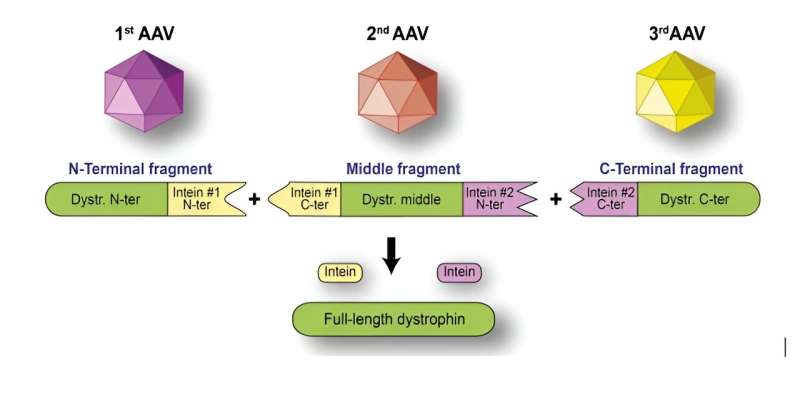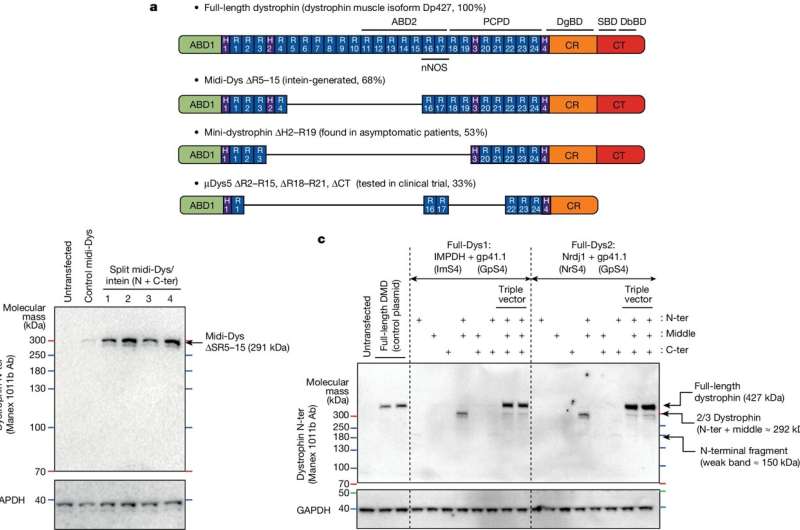This article has been reviewed according to Science X's editorial process and policies. Editors have highlighted the following attributes while ensuring the content's credibility:
fact-checked
peer-reviewed publication
trusted source
proofread
New gene therapy for muscular dystrophy offers hope

A new gene therapy treatment for Duchenne muscular dystrophy shows promise of not only arresting the decline of the muscles of those affected by this inherited genetic disease, but perhaps, in the future, repairing those muscles.
The UW Medicine-led research focuses on delivering a series of protein packets inside shuttle vectors to replace the defective DMD gene within the muscles. The added genetic code will then start producing dystrophin, the protein lacking in patients with muscular dystrophy.
Currently, there is no cure for the disease and available treatments and drugs only slow down the disease. In the case of Duchenne muscular dystrophy—the topic of this study—patients, all males because the gene is on the X chromosome, begin exhibiting symptoms around age 4 and usually die in their 20s or 30s.
Findings on the new gene therapy were published today in Nature.
UW Medicine neurologist and geneticist, Dr. Jeffery Chamberlain, the study's senior author, has worked his entire career on finding therapeutics and seeking a cure for muscular dystrophy. He is director of the Wellstone Muscular Dystrophy Research Center and is the McCaw endowed chair in muscular dystrophy at the University of Washington School of Medicine. The research project was led by molecular biologist Dr. Hichem Tasfaout working in the Chamberlain lab.
What has stymied researchers in the past is the gene which needs to be fixed is the largest gene in nature, Chamberlain noted. Up until now, there was no way to deliver adequate protein fixes into the muscles.
"Think of having a king-sized bed delivered that you can't get through your door," he said.
The new method, which has had success on mouse models, uses a series of adeno-associated viral vectors or AAVs, which are tiny shuttles derived from a virus that are being used to deliver gene therapies into human cells. Instead of one AAV, this gene therapy uses a series of AAVs which take parts of the therapeutic protein inside the muscles, along with embedded instructions to begin assembling the necessary genetic fix once within the body.

Back to the king bed analogy again, not only are the parts taken in piece by piece, but the delivery workers begin assembling the bed once inside the house. The next step for the therapy is human trials, which should begin in approximately two years, Chamberlain said.
In the lab, this method has not only halted further progression of the disease, but it has been able to reverse much of the pathology associated with dystrophy. Eventually, Chamberlain and Tasfaout hope that this method might lead to a reversal of the muscle wasting and restore normal health of the muscle tissue.
The latest approach also uses a new type of AAV vector that allows the use of lower doses and therefore may reduce or eliminate some of the side effects of previous approaches, Chamberlain said.
"When we infuse a large dose of these delivery shuttles, the body goes 'Whoa, what's going on here?'" he said.
This then kicks off an immune response which can damage the heart or liver, he explained.
Chamberlain remembers watching the Jerry Lewis Telethon as a kid and wanting to help those children. That feeling may have been a spark for the passion which eventually guided his career. He ended up being an expert who discussed the science of therapies on the telethon about seven times.
"When you meet families and patients it just inspired me to work that much harder," he said.
More information: Jeffrey Chamberlain, Split intein-mediated protein trans-splicing to express large dystrophins, Nature (2024). DOI: 10.1038/s41586-024-07710-8. www.nature.com/articles/s41586-024-07710-8


















